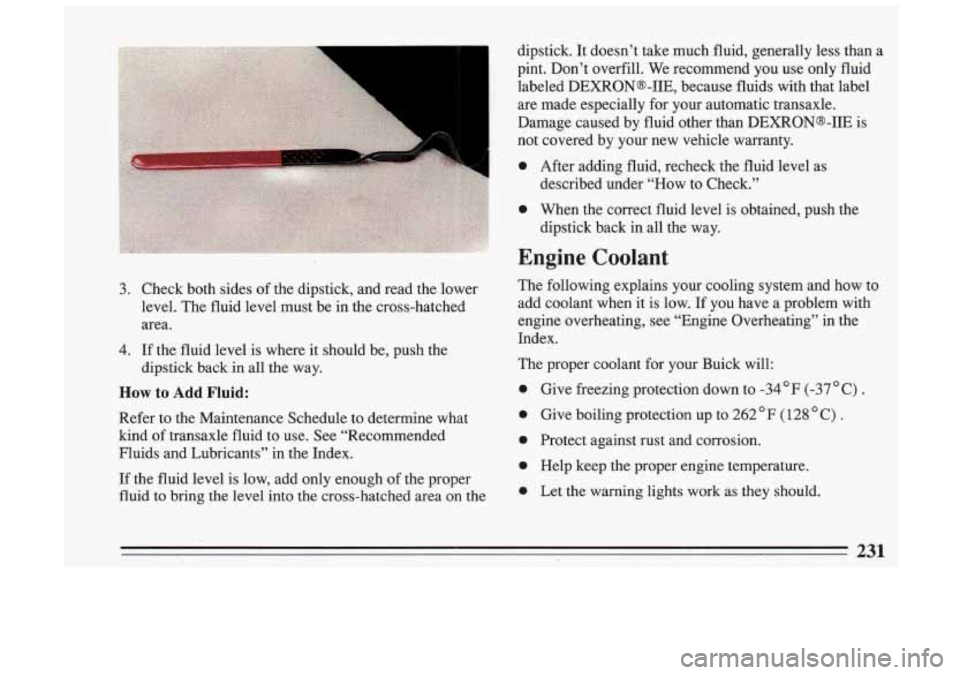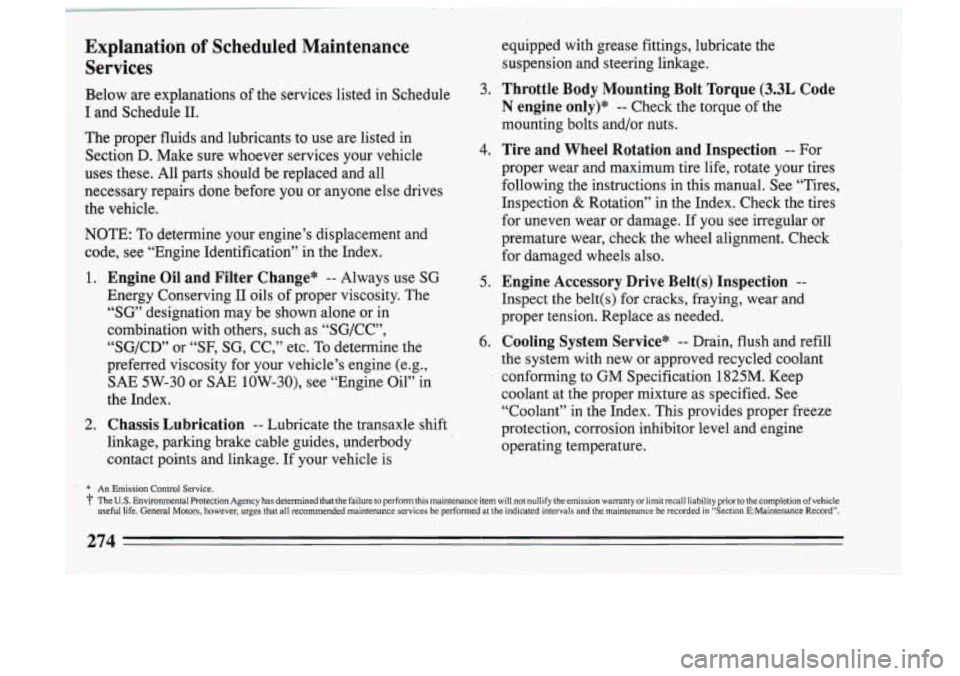1993 BUICK SKYLARK oil temperature
[x] Cancel search: oil temperaturePage 226 of 306

What Kind of Oil to Use:
Look for three things:
SG
“SG’ must be on the oil container, either by itself or
combined with other quality designations, such
as
“SG/CC,” “SG/CD,” “SF,SG,CC;” etc. These letters
show American Petroleum Institute (API) levels
of
quality.
I
0 SAE low-30 (V6 3.3L LG7 Engine)
As shown in this viscosity chart,
SAE 1OW-30 is
best for your vehicle. However, you can use SAE
5W-30
if it’s going to be colder than 60 OF ( 16 C)
before your next oil change. When it’s very cold,
below
O°F (-18 C), you should use SAE 5W-30.
RECOMMENDED SAE VISCOSITY GRADE ENGINE OILS
FOR BEST FUEL ECONOW AND COLD 16, SELECT THE LOWEST
SAE VISCOSITY GRADE OIL
FOR THE El.. -_ .-J TEMPERATURE RANGE.
HOT
WEATMER
r
“F
k100
+ 80
+ 60
+ 40
+ 20
0
f
r
“C
. +38
.+27
- +16
.+4
.-7
. -18
WEATHER LOOK
LABEL
FOR THIS IOW-30
1
-
-
above WF
SAE 5W-30
IF NEITHER SAE 5W-30 NOR SAE 1OW-30 GRADE OILS’ARE AVAILABLE, SAE 30 GRADE MAY BE USED AT TEMPERATURES
ABOVE 40 DEGREES F (4 DEGREES C).
ANY OTHER GRADE
OIL NOT RECOMMENDED
DO NOT USE SAE 1OW-40,
SAE 2OW-50 OR
Page 227 of 306

RECOMMENDED SAE VlSCOSlTY GRADE ENGINE OILS
FOR BEST FUEL ECONOMY AND COLD STARTING, SELECT THE LOWEST
SAE VISCOSITY GRADE
OIL FOR THE EXPECTED TEMPERATURE RANGE.
HOT
WEATHER
COLD
FOR LOOK THIS @
LABEL
5W-30
"t'LcoNse94'
IE 1OW-30
SAE 5W-30 PREFERRED
IF NEITHER SAE 5W-30 NOR SAE low-30
GRADE OILS ARE AVAILABLE, SAE 30 GRADE MAY BE USED AT TEMPERATURES
ABOVE 40 DEGREES F (4 DEGREES C). WEATHER
DO NOT USE SAE 1OW-40, SAE 2OW-50 OR
ANY OTHER GRADE OIL NOT RECOMMENDED
SAE 5W-30 (L4 2.3L L40 Engine)
As shown in this viscosity chart, SAE
5W-30 is best
for your vehicle. However, you can use
SAE low-30
if it's going to be
0 OF (- 18 C) or above.
These numbers on an oil container show its viscosity, or
thickness.
Energy Conserving I1
Oils with these words on the container will help you
save fuel.
This doughnut-shaped logo (symbol) is used on most oil
containers to help you select the correct oil.
You should look for this on the oil container, and use
only those oils that display the logo.
GM Goodwrench@ oil (in Canada,
GM Engine Oil)
meets all the requirements for your vehicle.
Engine Oil Additives: Don't add anything to your oil.
Your Buick dealer is ready to advise if you think
something should be added.
When to Change Engine Oil: See if any one of these
is true for you:
Most trips are less than 4 miles (6 km).
226
I
1
Page 232 of 306

0
0
0
0
0
Give freezing protection down to -34°F (-37 "C) .
Give boiling protection up to 262 F (128 " C) .
Protect against rust and corrosion.
Help keep the proper engine temperature.
Let the warning lights work
as they should.
231
Page 271 of 306

I
b Scheduled Maintenance Services Schedule I -
Follow Schedule I if your car is MAINLY driven under one or more of the following conditions:
0 When most trips are less than 4 miles (6 kilometers).
0 When most trips are less. than 10 miles (16 kilometers) and outside temperatures remain below freezing.
0 When most trips indude extended idling and/or frequent low-speed operation as in stop-a\
nd-go traffic.
0 Towing a trailer."?
0 When operating in dusty areas.
Schedule I should also be followed if the car is used for delivery service, police, taxi or other commercial app\
lications.
TO BE SERVICED
(See Explanation of
Scheduled Maintenance Miles (kilometers) or
Services Following Months, Whichever
WHEN
TO PERFORM
Schedules I and 10
Item No. I
Occurs First
1. hgine
Oil & Filter Change months I
Every 3000 mi. (5000 km) or
2. Chassis Lubrication I Every other oil change
3. Throttle Body Mounting At 6 000 mi. (10 000 km)
Bolt Torque*
At
6 000'mi. (10 000 km) and
km) or as necessary
4. Tire & Inspection & then every 15 000 mi. (25 000
Rotation
5. Engine Accessory Drive
Belt(s) Inspection* Every
30 000 mi. (50 000 km) or 24 months.
MILES (000)
3 16 19 112115118121124127130(33136139142145148
5 10
a.
..
0
0
KILOMETERS (000)
65 70 75 80
a...
0 a
270
Page 275 of 306

Explanation of Scheduled Maintenance equipped with grease fittings, lubricate the
Services suspension and steering linkage.
Below are explanations
of the services listed in $chediie ‘ ‘ 3. Throttle Body Mounting; Bolt Torque (3.3L Code . , I:
I and Schedule 11.
The proper fluids and lubricants to use are listed in
Section
D. Make sure whoever services your vehicle
uses these. All parts should be replaced and all
necessary repairs done before you or anyone else drives
the vehicle.
NOTE:
To determine your engine’s displacement and
code, see “Engine 1dentific.ation” in the Index.
1. Engine Oil and Filter Change* -- Always use SG
Energy Conserving
I1 oils of proper viscosity. The
“SG, designation may be shown alone or in
combination with others, such as “SG/CC”,
“SG/CD” or “SF,
SG, CC,” etc. To determine the
preferred viscosity for your vehicle’s engine (e.g.,
SAE 5W-30 or SAE 10W-30), see “Engine Oil” in
the Index.
2. Chassis Lubrication -- Lubricate the transaxle shift
linkage, parking brake cable guides, underbody
contact points and linkage. If your vehicle is
An Emission Control Service.
N engine only)* -- Che& the torque of the
mounting bolts and/or nuts.
proper wear and maximum tire life, rotate your tires
following the instructions in this manual. See “Tires,
Inspection
& Rotation” in the Index, Check the tires
for uneven wear or damage. If you see irregular or
premature wear, check
the wheel alignment. Check
for damaged wheels also.
5. Engine Accessory Drive Belt@) Inspection --
Inspect the belt(s) for cracks, fraying, wear and
proper tension. Replace as needed.
6. Cooling System Service* -- Drain, flush and refill
the system with new or approved recycled coolant
conforming to GM Specification 1825M. Keep
coolant at the proper mixture as specified. See
“Coolant” in the Index. This provides proper freeze
protection, corrosion inhibitor level and engine operating temperature.
4. Tire and Wheel Rotation and Inspection -- For
The U.S. Environmental Protection Agency has determined that the failure to perform this maintenance item will not nullify the emission war\
ranty or limit recall liability prior to the completion of vehicle
useful life. General Motors, however, urges that all recommended maintenance services be performed at the indicated i\
ntervals and the maintenance be recorded in “Section EMaintenance Record”.
274
Page 276 of 306

Inspect hoses and replace if they are cracked,
swollen or deteriorated. Tighten screw-type hose
clamps. Clean the outside of the~radiator and air
conditioning condenser. Wash the pressure cap and
neck.
To help ensure proper operation, we recommend a
pressure test
of both the cooling system and the
pressure cap.
7. Transaxle Service -- Change both the fluid and
filter every
15,000 miles (25 000 km) if the vehicle
is mainly driven under one or more of these
conditions:
0 In heavy city traffic where the outside
temperature regularly reaches
90 F (32 C) or
higher.
0 In hilly or mountainous terrain.
When doing frequent trailer towing. (With some
models, you shouldn’t ever tow a trailer. See
“Towing a Trailer” in the Index.)
Uses such as found in taxi, police car or delivery
service. If you
do’ not use your vehicle under any of these
conditions, change both the fluid and filter every
100,000 miles (160 000 km).
8. Spark Plug Replacement* -- Replace spark plugs
with the proper type. See “Specifications Chart” in
the Index.
9. Spark Plug Wire Inspection (3.3L Code N engine
only)*?
-- Inspect for burns, cracks or other
damage. Check the boot fit at the coils and at the
spark plugs. Replace wires as needed.
10. Air Cleaner Filter Replacement* -- Replace every
30,000 miles
(50 000 km) or more often under dusty
conditions. Ask your dealer for the proper
replacement intervals for your driving conditions.
11. Fuel Tank, Cap and Lines Inspection”? -- Inspect
fuel
tank, cap and lines (including fuel rails and
injection assembly) for damage or leaks. Inspect fuel
cap gasket for an even filler neck imprint or any
damage. Replace parts as needed. Periodic
replacement of the fuel filter is not required.
* An Emission Control Service.
The
U.S. Environmental Protection Agency has determined that the failure to perform this maintenance item will not nullify the emission warranty or limit recall liability prior to the completion of vehicle
useful life. General Motors, however, urges that all recommended maintenance services be performed at the indicated intervals and the maintenance be recorded in “Section EMaintenance Record”.
Page 304 of 306

...... a . c
Underbody Maintenance ......................... 255
Uniform Tire Quality Grading
...................... 245
Unleaded Gasoline
............................... 2 17
Uphill Parking
.................................. 173
Upholstery Care
................................. 249
Used Oil. How to Dispose
of ....................... 227
Used Replacement Wheels
......................... 248
Vehicle Damage Warnings
......................... 11
Vehicle Identification Number ...................... 257
Vehicle Storage
................................. 237
Vehicle Symbols
.................................. 12
Volts Gage
..................................... 116
Vinyl. Cleaning
................................. 251
Visor Vanity Mirror
.............................. 104
warnings Devices
.............................. 187
Warning. Hazard Flasher
.......................... 186
Warning Lights
Antilock Brake System
......................... 11 1
Battery
....................................... 116
Brakesystem
................................ 110
CheckOil
................................... 115
Engine Coolant Temperature
.................... 112
Engine Oil Pressure
............................ 114
Indicators and Gages on Instrument Panel
.......... 109
LowCoolant
................................. 113
Malfunction Indicator (Service Engine Soon)
....... 11 3
I
Warnings. Safety ................................. 10
Washer. Windshield
............................... 92
Wear Indicators. Disc Brake
....................... 152
Weather Strips
.................................. 254
Weight.of a Trailer
............................... 180
Wheel Alignment
................................ 246
Wheel Covers Removal
........................... 206
Wheel Replacement
.............................. 247
White Sidewall Tire Cleaning
...................... 254
Why Wear Safety Belts?
........................... 23
Windows. Power
................................. 87
Windshield
Cleaning
.................................... 252
Washer
..... : ................................ 92
Washer Fluid
.............................. 92. 235
Wipers
................................... 9252 1.
Winter Driving
.................................. 175
Working on Your Car
............................. 216
Worn Tires
..................................... 244
Wrecker Towing
................... ............. 193
Washing Your Vehicle
............................ 253
WheelNutTorque
............................... 211
Your Driving and the Road
....................... 137
Your Own Signals
............................... 144
Your Vehicle and the Environment
.................. 267